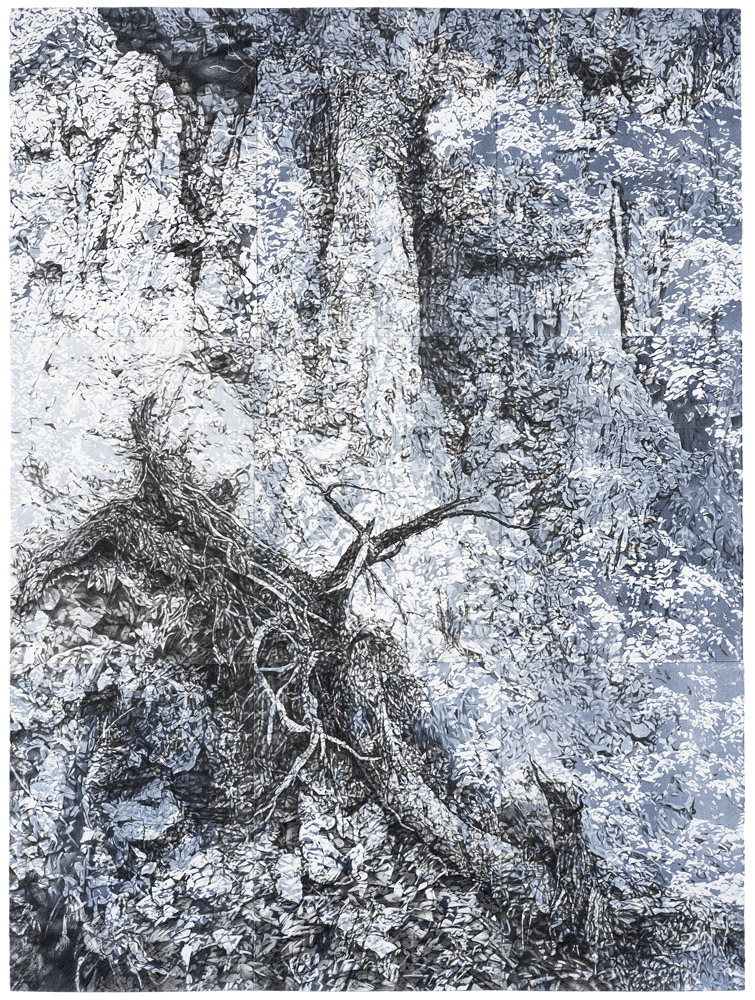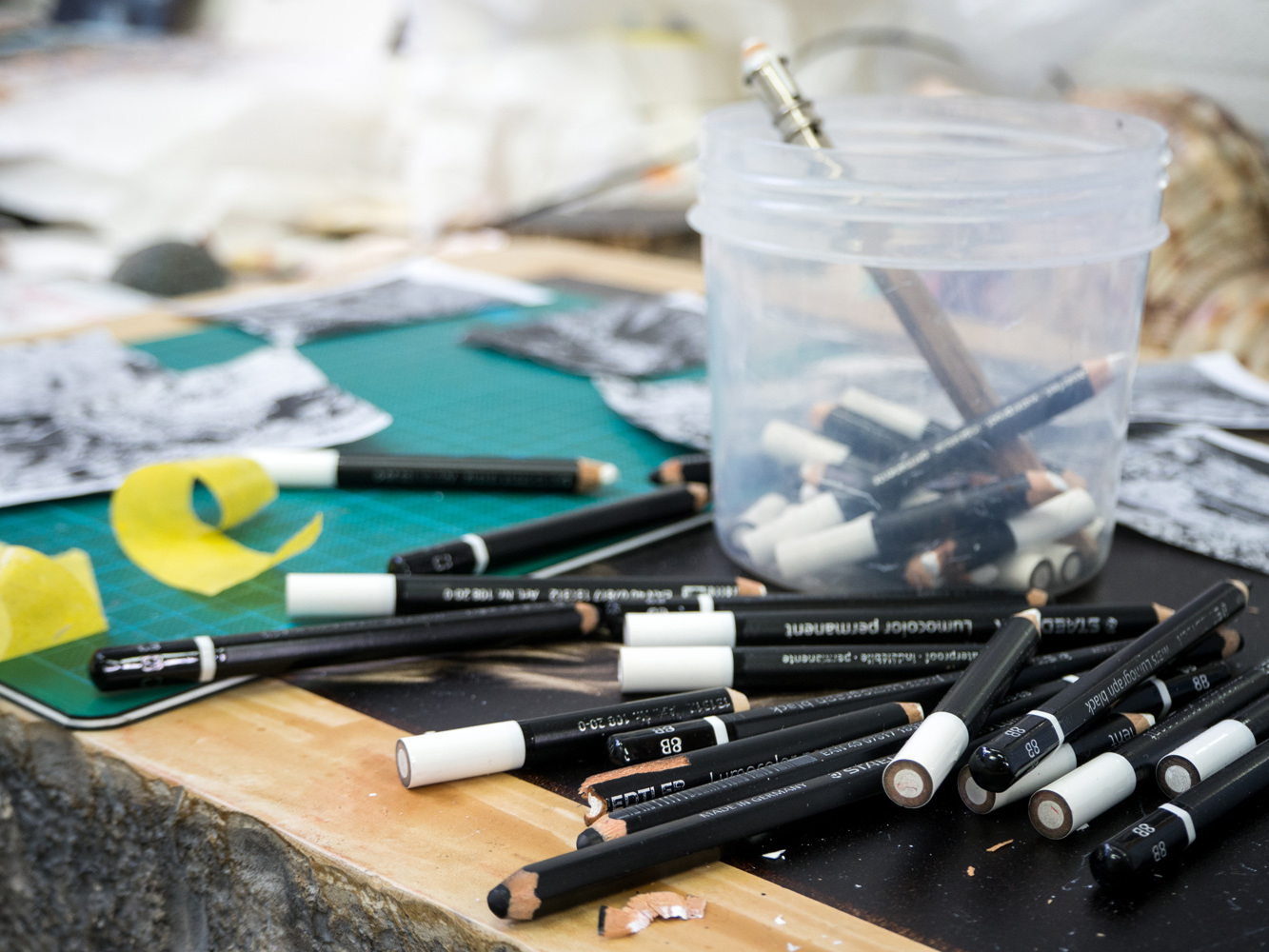I'm looking forward to heading to Melbourne next week for the opening of my solo exhibition 'Ghosts' at Flinders Lane Gallery! The exhibition is on display from May 1st - May 19th. If you're in Melbourne, please drop in for a drink and a chat between 1-3pm on Saturday May 5th. If you're not in Melbourne you can always check out the exhibition online.
Ghost IV, 2018, pencil and monotype on paper, 228cmx168cm
Catalogue Essay
by Tess Horwitz, 2018
Annika Romeyn’s art is a call to remembrance of the natural world around us – its power and its fragility.
‘Ghosts’ responds to the riven, pockmarked landscape of Golden Gully, which Annika experienced during a Bathurst Regional Gallery Hill End Residency in 2015. Hill End has endured the legacy of the gold rush: land clearing, erosion, heavy metal contamination and the re-diversion of rivers. Trees bear witness – clinging precariously to crumbling gully walls or lying uprooted where earth has given way. Trees, too, re-inhabit and reclaim. We are faced with historical evidence of human economic greed and disregard for nature, and of nature’s slow reparations.
Damaged but gradually growing over, the landscape of Hill End seems to derive from a less rapacious time. The damage is slight compared with the proposed Adani mine in Queensland, which would destroy 28,000 hectares, consume 12 billion litres of water annually, and release 2.3 billion tonnes of thermal coal into the atmosphere. In so many ways our world is teetering on a precipice. We live in the Anthropocene Epoch where human activities are causing major shifts in the operations of nature, maybe even those parts we assumed to be immutable.
In immersive, large-scale works Annika’s body makes the marks, her hand is visible, stroking beauty into being, healing and resurrecting. The ordinary and the wounded are transformed into the magical, into realms for the imagination. Since her early studies in illustration, Annika’s practice has centred on close and patient observational drawing, which here melds with the techniques of printmaking to create in the viewer a sense of humility in the face of the complexity and longevity of trees and of nature.
“Art is a kind of mining”, writes Jane Urquhart, “The artist a variety of prospector searching for the sparkling silver of meaning in the earth”. There is so much curiosity and so much deep looking in Annika’s exquisitely detailed work. Her dramatic use of perspective forces us to look upward like ground-hugging insects. In multi-layered drawings, perspectives shift and intersect inviting us to move through and within the landscape. The earth is always there, mediating our self-image.
These works began with subtractive and direct drawing – Annika wiped away ‘light’ from a field of indigo printing ink with the pressure of her index finger wrapped in cotton rag. The monotype technique allows for a single impression, with a couple of progressively faded impressions taken from the residual ink left on the plate. These faded second-run prints, commonly referred to as ‘ghost prints’ evoked a fitting sense of memory, distance and ambiguity, which Annika worked with in further layers drawn with carbon and white pencils.
Over the softer, bluer ‘ghosts’, Annika draws the resilience of the natural world back into being. Ravaged trees and eroded earth appear animate, confounding us with their beauty and their awe-inspiring scale. These works are powerful observational investigations of the land, but they are also parables about human power and human insignificance.
References:
Nathan Nagle, Distribution and dispersal of Legacy Sediment and contamination from Historical Gold Mining at Hill End, New South Wales, Australia, Masters of Research thesis, Dept of Environment and Geography, Macquarie University, October 2014
Jane Urquhart, The Underpainter, Penguin Books, 1997
Exhibition Statement:
Ghosts is a solo exhibition of new work by Annika Romeyn. The work began with a Bathurst Regional Gallery Hill End Residency (Nov 2015) spent walking and drawing outdoors in Golden Gully. Annika experienced a surreal landscape bearing the scars of colonial mining – raw and damaged, yet intriguing and somehow transcendent. It is a place that has continued to transform in Annika’s memory, imagination and ultimately through her layering of drawing and printmaking processes.
Annika’s work is inspired by being in the landscape and the experience of wonder and mutability that comes with a close and patient observation of nature. Focusing on sheer cliff faces and twisted trees - fallen or teetering on the precipice, Annika’s work speaks of erosion, impermanence and the precarious state of our natural environment.
Annika would like to express her gratitude to Bathurst Regional Gallery and ArtsACT for supporting her Hill End Residency (November 2015).













